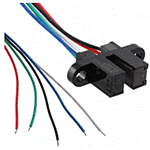Connector Manufacturers Connect to Sensors
The marriage of high-reliability connectors and sensors brings a new facet of connectivity to the interconnect industry.
 Connector Manufacturers Connect to Sensors
Connector Manufacturers Connect to Sensors
The physical and digital worlds are merging and sensors of all types are on the front line of that evolution. The emerging Internet of Things is essentially a network of connected sensors that gather the data that makes the IoT possible. Devices that sense and measure specific aspects of the physical world are the eyes and ears of the IoT.
The list of parameters that electronic sensors are able to measure is expanding to meet the challenge of advanced applications. A short list of sensor types that are able to quantify a vast array of physical properties includes:
|
|
 Many of these devices utilize microelectromechanical (MEMS) as well as piezoresistive technologies to achieve goals of miniaturization and low power consumption.
Many of these devices utilize microelectromechanical (MEMS) as well as piezoresistive technologies to achieve goals of miniaturization and low power consumption.
Connections to the sensor are accomplished in a number of ways. Discrete sensors are supplied with wire or flex cable leads that can be connectorized or simply soldered directly to the associated electronics.

Larger sensors may feature an integrated connector that can simplify installation or replacement.
 Others are designed for termination directly to a printed circuit board and may be provided with surface-mount or through-hole tails for solder attachment.
Others are designed for termination directly to a printed circuit board and may be provided with surface-mount or through-hole tails for solder attachment.
Demand for sensors in mobile and wearable product applications has resulted in the development of sensors in subminiature profiles.
 Automotive-related sensors often feature an integrated connector interface that is molded as part of the assembly and features environmental sealing.
Automotive-related sensors often feature an integrated connector interface that is molded as part of the assembly and features environmental sealing.
Other sensors are fully self-contained units that wirelessly transmit to a router or gateway. They may be powered by an external power source, internal battery, or locally harvested energy.
Single-chip devices now entering the market feature multiple sensor functions that increase efficiency, optimize PCB utilization, and lower cost.
It appears that we will be surrounded by a matrix of embedded sensors that will allow the automation of our homes, offices, and factories. Sensors have become a key element of electronic equipment in such diverse market segments as automotive, industrial, medical, appliance, aerospace and defense, industrial, and commercial transportation.
Sensors designed for smart home applications such as fire, smoke, and intrusion detection as well as water and temperature controls have been on a slow but continuous growth curve for years. Some of these sensors are wired directly to a device while others connect wirelessly and can operate for years powered only by a coin cell battery. Recent advances in new software platforms such as the Amazon Echo as well as progress in device compatibility have been a boost to smart home adoption.
More advanced devices incorporate a level of artificial intelligence that enables equipment to learn from experience to reduce the degree of manual human intervention. The Nest thermostat is an early example of this emerging class of sensor-driven product that learns but also can be remotely adjusted via a smartphone. Sensor networks now in development will trigger on upon occupation of a room and recognize individuals to adjust conditions to their specific preferences.
The typical car today contains dozens of sensors that provide the data necessary to control the engine, transmission, braking, and lane tracking as well as a host of safety, communication, and comfort features. Advances toward the fully autonomous car will require even more sensors with the added demand for high reliability in harsh environments.
Smart automation is poised to change the way products are manufactured. Sensors are now being implemented in applications that range from machine health and data logging to smart utility meters. Sensors are being used to maintain tight process control that would be impossible to achieve manually.
General Electric has opened a development center that is developing a computer operating system specifically for industrial equipment. The objective is to meld inexpensive sensors, powerful computers, and smart software to support the industrial IoT as well as allow industrial machines to communicate directly. It is competing against long-term segment leaders that include Rockwell Automation, United Technologies, IBM, and Siemon, as well as newcomers Cisco, Google, and Microsoft. The market potential offered by the fourth industrial revolution justifies this exceptional level of investment.
There is a natural synergy between sensors and connectors. Although the manufacturing process for connectors and sensors is quite different, both types of products create essential connections between the physical and digital worlds. Wherever sensors are being used, connectors are often close by. Market forecasts predict huge increases in sensor sales, a fact that has been noticed by several leading connector manufacturers.
Amphenol Advanced Sensors leverages its acquired manufacturing expertise and established customer relationships to design and build a variety of sensors to address applications in aerospace, automotive, healthcare, industrial, and pharmaceutical markets. Sensors are marketed under the product brands of Kaye, NovaSensor, Protimeter, Telaire, and Thermometrics. Device types include moisture meters, temperature sensors, MEMS pressure sensors, CO2 sensors, and humidity sensors.
Molex has entered the sensor market in three arenas. Its deep penetration in automotive connector markets makes automotive sensors a logical market choice. Products currently offered include air bag, airflow, pressure, radar, rollover, temperature, knock, parking, and tire pressure sensors. A second focus is on capacitive fluid-level sensors used in agriculture, fluid tanks, and medical liquid-level applications.
 The Molex Soligie printed electronic sensor is a custom sensor solution in the form of a flat circuit assembly. Sensors can be built in a roll-to-roll process to achieve high-volume efficiency.
The Molex Soligie printed electronic sensor is a custom sensor solution in the form of a flat circuit assembly. Sensors can be built in a roll-to-roll process to achieve high-volume efficiency.
According to Amanda Mellencamp of TE Connectivity Investor Relations, TE has had in-house sensor manufacturing capability to support its extensive automotive business. In 2014 it began to increase sensor resources through acquisition of several companies including Measurement Specialties, American Sensor Technologies, and Jaquet Technology Group. These additions dramatically expanded its sensor product portfolio as well as reinforced its corporate focus on applications in harsh environments. TE has opened a high-tech sensor design and manufacturing center in Andover, Minn., with the intent of developing custom sensor solutions for customers across multiple industries.
The marriage of high-reliability connectors and sensors brings a new facet of connectivity to the interconnect manufacturing industry along with the prospect of increased sales growth.
[related_posts limit=”10″]
- Optics Outpace Copper at OFC 2024 - April 16, 2024
- Digital Lighting Enhances your Theatrical Experience - March 5, 2024
- DesignCon 2024 in Review - February 13, 2024




